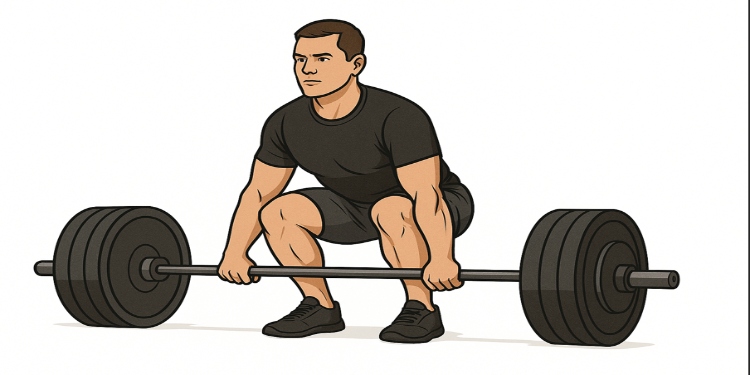“Success in the gym often comes down to the smallest adjustments.” – Michael Geraghty
You can load the bar, manage your rest periods and track every set. But if you’re not paying attention to your grip, you could be missing out on real progress.
The way you hold a bar isn’t just a minor detail. It’s a choice that shapes muscle activation, affects joint strain and influences how effectively you move. Even a small change in grip can shift the load to entirely different muscle groups. That isn’t just helpful. It’s essential.
Here’s why grip matters more than most people think.
Your Hands Are Doing More Than You Realise
Most people default to whatever grip feels most natural. But natural doesn’t always mean most effective. Every grip style recruits different muscles and creates a different mechanical demand on the body.
Here are the main types:
- Pronated Grip (Overhand): Palms facing down. Often used in deadlifts, pull-ups and barbell rows.
- Supinated Grip (Underhand): Palms facing up. Used for chin-ups, curls and underhand rows.
- Neutral Grip: Palms facing each other. Common in hammer curls, dumbbell pressing and certain cable exercises.
Each grip changes the angle of the wrists and elbows, which in turn shifts which muscles are taking the load.
Supinated Grip: Focused on the Arms
With the palms facing upwards, a supinated grip sends the effort straight into the biceps. You’ll see it in exercises like chin-ups, barbell curls and underhand rows. The elbows remain tucked in and the biceps take most of the tension.
This grip is ideal for isolation work. The biceps brachii, brachialis and forearm flexors all get targeted.
However, it’s not suitable for every movement. It limits grip strength during heavy pulling and can place added strain on the wrists or elbows if overused. Still, for building arm size and definition, it’s extremely effective.
Pronated Grip: Power and Stability
This is the standard grip for most compound lifts. With the palms facing down, the body finds a stable and strong position for pulling and pressing movements.
It’s the primary choice for deadlifts, pull-ups, overhead presses and rows. The pronated grip activates the lats, traps, rhomboids and rear delts, making it ideal for building a strong upper back and posterior chain.
It doesn’t involve the biceps as much as other grips, so if your arms are lagging, this might be why. Even so, for back development, it remains a cornerstone.
Neutral Grip: Comfortable and Balanced
A neutral grip has the palms facing one another. It’s often seen in hammer curls, neutral-grip pull-ups and exercises using dumbbells or cable attachments.
This grip reduces stress on the wrists and shoulders, making it a joint-friendly option. It also balances muscle engagement across the biceps, brachialis and forearms.
It may not let you lift the heaviest loads or isolate one muscle group as much, but it is excellent for long-term training, especially for injury prevention or recovery phases.
How Grip Changes the Outcome
You don’t have to overhaul your entire training programme to see progress. Sometimes, simply changing your grip is enough to unlock new gains.
Here’s how grip affects key exercises:
- Pull-ups:
- Pronated grip = more upper back and lats
- Supinated grip = more biceps involvement
- Neutral grip = balanced activation between arms and back
- Pronated grip = more upper back and lats
- Curls:
- Supinated = classic biceps isolation
- Pronated (reverse curls) = targets the forearms
- Neutral (hammer curls) = ideal for the brachialis
- Supinated = classic biceps isolation
- Rows:
- Pronated = emphasises the lats and back width
- Supinated = more mid-back and biceps focus
- Neutral = great for joint health and accessory work
- Pronated = emphasises the lats and back width
If your progress has stalled, changing your grip could provide the new stimulus your body needs.
Mixed Grip: Strength Over Symmetry
A mixed grip means one hand uses a pronated grip and the other uses a supinated grip. It’s commonly seen during heavy deadlifts to improve grip security and prevent the bar from rolling.
This grip is practical and can help you lift heavier loads. However, it creates asymmetry across the body and can lead to imbalances over time.
To prevent that, alternate your hand positions with each set, or reserve mixed grip for your heaviest lifts only.
When to Change Your Grip
There is no single grip that works best for every situation. The smartest approach is to rotate grips depending on your goals, how your body feels and what you’re training.
Here are some helpful guidelines:
- Change grip focus every 4 to 6 weeks to prevent overuse and target new muscle fibres.
- If you’re experiencing joint discomfort, especially in the wrists or shoulders, shift to a neutral grip.
- For heavy pulling movements like deadlifts, use a mixed or hook grip to maintain control without compromising your form.
- If your arms are not growing, include more supinated and neutral grip exercises across your week.
Rotating grips regularly can help prevent injury and maintain strength gains across a wider range of movements.
Final Thoughts
Many lifters obsess over training splits, volume and supplements. But often, real progress comes from the small details.
Grip is not just about holding the bar. It shapes your results. It changes which muscles are activated, how your joints behave and how safely you can train.
Use a supinated grip to focus on the biceps. Use a pronated grip to develop your back. Use a neutral grip when joint health or balanced strength is the priority.
Rotate grips regularly. Be intentional with your hand position. Train with purpose.
You’ll notice the difference in your performance. And your body will thank you for it.
Written and prepared by Michael Geraghty at SuperStrong Fitness












































































